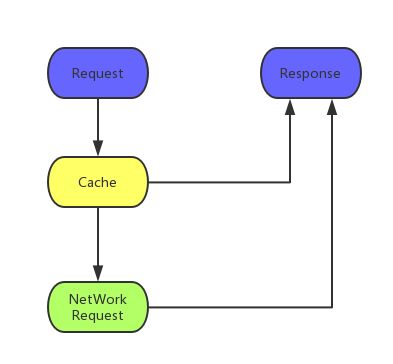Volley是Google I/O 2013上发布的一个网络通信库,本文将基于Android N Frameworks层中的Volley源码进行分析。
Volley框架介绍:
在计算机网络发展中,诞生了两种经典的计算机网络参考模型:OSI参考模型与TCP/IP参考模型,其中的分层如下所示:
| OSI七层模型 | TCP/IP四层模型 | 传输的数据 |
|---|---|---|
| 应用层 | 应用层 | 数据 |
| 表示层 | 应用层 | 数据 |
| 会话层 | 应用层 | 数据 |
| 传输层 | 传输层 | 段 |
| 网络层 | 网际互联层 | 包 |
| 数据链路层 | 网络接入层 | 帧 |
| 物理层 | 网络接入层 | 比特流 |
而目前Android开发中常提及的各种网络框架面向的网络层也是不同的,针对TCP/IP四层模型中,现在使用较多的OKHttp,HttpClient, URLConnection都是面向传输层的网络框架,而Retrofit, AsyncHttp, Volley则是依托于这些面向传输层的网络框架。其中Retrofit中默认采用OKHttp作为其网络传输层,AsyncHttp则默认采用HttpClient,而Volley中,对于API Level大于8的采用URLConnection作为网络传输层,而小于等于8的采用HttpClient作为网络传输层,同时它支持定义OKHttp作为其网络传输层。对于一些说Volley是基于OKHttp进行封装的网络库,这种说法其实并不准确。
Volley简单使用
Volley的使用大致分为三步:请求初始化、构建请求参数、设置请求回调、执行请求。如下所示是简单的Volley请求写法。
RequestQueue mQueue = Volley.newRequestQueue(context);
StringRequest stringRequest = new StringRequest(url,
new Response.Listener() {
@Override
public void onResponse(String response) {
Log.d("TAG", response);
}
}, new Response.ErrorListener() {
@Override
public void onErrorResponse(VolleyError error) {
Log.e("TAG", error.getMessage(), error);
}
});
mQueue.add(stringRequest);
Volley源码分析
Android 7.0 源码中关于Volley的库位于frameworks/volley包下。现我们将按Volley的使用步骤进行源码的分析:
Volly RequestQueue的初始化
Volley调用的newRequestQueue有两类构造方法:newRequestQueue(Context context)与newRequestQueue(Context context, HttpStack stack),如果不选择传入HttpStack,则Volley将以传入null的形式调用后一方法。其具体实现如下所示:
File cacheDir = new File(context.getCacheDir(), DEFAULT_CACHE_DIR);
String userAgent = "volley/0";
try {
String packageName = context.getPackageName();
PackageInfo info = context.getPackageManager().getPackageInfo(packageName, 0);
userAgent = packageName + "/" + info.versionCode;
} catch (NameNotFoundException e) {
}
if (stack == null) {
if (Build.VERSION.SDK_INT >= 9) {
stack = new HurlStack();
} else {
stack = new HttpClientStack(AndroidHttpClient.newInstance(userAgent));
}
}
Network network = new BasicNetwork(stack);
RequestQueue queue = new RequestQueue(new DiskBasedCache(cacheDir), network);
queue.start();
我们可以看到,对于stack的处理:如果默认传入HttpStack的实例stack为空,则会根据SDK API版本选择不同的实现类.其中HurlStack与HttpClientStack都是HttpStack的实现类,从名称上以可以看的出来,HurlStack是封装的HttpURLConnection,而HttpClientStack是封装的HttpClient。其具体的封装与请求使用我会在其他文章中进行详细分析。此处不再详述。
BasicNetWork是Network接口的实现类,其中接口的实现方法performRequest(Request request)中会调用请求Request去真正执行网络请求。此处的start()方法只是调用RequestQueue的start()方法启动CacheDispatcher与NetRequestDispatcher两个请求转发线程,具体请参考后文的RequestQueue的start方法分析。
Volley RequestQueue的构造函数
在RequestQueue中start()方法启动前,会调用RequestQueue构造方法进行初始化,将NetWork实现类和默认的缓存传入RequestQueue中,完成RequestQueue的初始化。其中最终调用的初始化方法如下所示:
public RequestQueue(Cache cache, Network network, int threadPoolSize,
ResponseDelivery delivery) {
mCache = cache;
mNetwork = network;
mDispatchers = new NetworkDispatcher[threadPoolSize];
mDelivery = delivery;
}
在构造方法中,RequestQueue中对传入各部分的参数注释如下:
- cache A Cache to use for persisting responses to disk (Cache 是一个接口定义,默认使用DiskCache来持久化响应结果)
- network A Network interface for performing HTTP requests (Network 是一个接口定义,默认使用BasicNetwork来执行HTTP请求)
- threadPoolSize Number of network dispatcher threads to create (使用NetworkDispatcher数组定义执行器容器,默认容器最大容量为4)
- delivery A ResponseDelivery interface for posting responses and errors (请求结果转发接口,默认使用ExecutorDelivery转发结果)
在构造函数之前的注释说明的更清楚一点:Creates the worker pool. Processing will not begin until {@link #start()} is called.,大意为创建工作池,但是在调用start方法之前,整个请求并不会真正开始工作。那么接下来我们便来分析RequestQueue的启动方法start()。
Volley RequestQueue的启动
RequestQueue中的start()方法中,会真正的开始执行一个请求队列,而在这之中,RequestQueue又会引入二个新的类型,分别为:CacheDispatcher与NetworkDispatcher,具体代码如下所示:
public void start() {
stop(); // Make sure any currently running dispatchers are stopped.
// Create the cache dispatcher and start it.
mCacheDispatcher = new CacheDispatcher(mCacheQueue, mNetworkQueue, mCache, mDelivery);
mCacheDispatcher.start();
// Create network dispatchers (and corresponding threads) up to the pool size.
for (int i = 0; i < mDispatchers.length; i++) {
NetworkDispatcher networkDispatcher = new NetworkDispatcher(mNetworkQueue, mNetwork,
mCache, mDelivery);
mDispatchers[i] = networkDispatcher;
networkDispatcher.start();
}
}
在启动任务之前会调用stop()方法确保当前没有正在运行任务这个比较好理解,而接下来创建的CacheDispatcher从构造方法传参看,其中又多了一个未曾在前面出现过的mCacheQueue,NetWorkDispatcher也多了一个未曾在前面出现过的mNetworkQueue。这两个集合类是在类变量声明时便进行初始化了:
private final PriorityBlockingQueue> mCacheQueue = new PriorityBlockingQueue>();
private final PriorityBlockingQueue> mNetworkQueue = new PriorityBlockingQueue>();
CacheDispatcher继承自Thread,从名称就可以看出,主要作用是管理缓存派发请求的。而NetworkDispatcher同样也继承自Thread,是处理缓存未派发的请求的。当调用其start()方法后,线程便会启动。我会在其他文章中对它的缓存派发和请求管理进行详细分析。此处不再详述
Volley 构建Request请求与注册监听
在Volley对RequestQueue初始化完毕后,我们需要构建请求,来完成我们的网络请求.在简单使用的代码中,构建请求使用的是StringRequest,它是抽象类Request的子类。Request的子类请求还有ImageRequest、JsonRequest。而JsonRequest是JsonArrayRequest与JsonObjectRequest的父类。对于Request类中,我们注意到,对于Request这个顶级父类,其监听只注册了一个ErrorListener,而结果监听则交给其实现类去注册,如StringRequest的结果监听为Listener、ImageRequest的结果监听为Listener、JsonArrayRequest注册的结果监听为Listener、JsonObjectRequest注册的结果监听为Listener。而JsonRequest的结果监听却支持范型传入Listener,从这点来说,笔者有些奇怪,既然支持范型定义,为何不直接在顶级父类定义封装,然后在子类中传入参数进行初始化使用呢? 从软件分层的角度来看,好像这样也更合理。希望对这个问题有想法的同学能提供些思路给我。
而对于不同的Request子类实现类,笔者会在以后对几种实现类进行详细分析。大致概括说来,Volley会对请求结果进行解析封装,以对应的类型包装回调回来,其是由抽象类中的deliverResponse()返回,其代码如下所示:
@Override
protected void deliverResponse(String response) {
mListener.onResponse(response);
}
而在 RequestQueue的初始化 中我们说过,BasicNetWork中的performRequest()方法是会去执行Request的网络请求,那它是要如何请求呢,这就需要我们将构建的请求与ReqeustQueue及其相关组件关联起来了,这就是我们下一步要介绍的RequestQueue的add()方法。
RequestQueue添加Request请求
在使用对应的Request构建好网络请求后,RequestQueue会调用其add()方法将构建的请求加入到请求队列中,其具体执行方法代码如下所示:
// If the request is uncacheable, skip the cache queue and go straight to the network.
if (!request.shouldCache()) {
mNetworkQueue.add(request);
return request;
}
// Insert request into stage if there's already a request with the same cache key in flight.
synchronized (mWaitingRequests) {
String cacheKey = request.getCacheKey();
if (mWaitingRequests.containsKey(cacheKey)) {
// There is already a request in flight. Queue up.
Queue> stagedRequests = mWaitingRequests.get(cacheKey);
if (stagedRequests == null) {
stagedRequests = new LinkedList>();
}
stagedRequests.add(request);
mWaitingRequests.put(cacheKey, stagedRequests);
if (VolleyLog.DEBUG) {
VolleyLog.v("Request for cacheKey=%s is in flight, putting on hold.", cacheKey);
}
} else {
// Insert 'null' queue for this cacheKey, indicating there is now a request in
// flight.
mWaitingRequests.put(cacheKey, null);
mCacheQueue.add(request);
}
return request;
}
从代码中可以看到,如果Request不允许缓存的话,Request直接加入到NetWorkQueue中就直接return了,而默认request是允许使用缓存的,当允许使用缓存时,如果WaitingRequestsQueue中没有相同的请求任务,则会将任务key加入到waitingRquests中,但是传入队列为空,然后将任务加入CacheQueue中。如果已经有同样的请求在运行,则会将新任务构建队列,加入到WaitingRequest中,但并不不执行。
将Request加入到CacheQueue中后,我们留意到CacheQueue后续没有操作了,这个原因在于,CacheQueue与前文中描述的CacheDispatcher耦合,CacheDispatcher作为一个线程死循环,在RequestQueue中已经启动,它会不停的遍历CacheQueue中的Request请求。其部分主要代码如下所示:
// Attempt to retrieve this item from cache.
Cache.Entry entry = mCache.get(request.getCacheKey());
if (entry == null) {
request.addMarker("cache-miss");
// Cache miss; send off to the network dispatcher.
mNetworkQueue.put(request);
continue;
}
// If it is completely expired, just send it to the network.
if (entry.isExpired()) {
request.addMarker("cache-hit-expired");
request.setCacheEntry(entry);
mNetworkQueue.put(request);
continue;
}
// We have a cache hit; parse its data for delivery back to the request.
request.addMarker("cache-hit");
Response response = request.parseNetworkResponse(
new NetworkResponse(entry.data, entry.responseHeaders));
request.addMarker("cache-hit-parsed");
if (!entry.refreshNeeded()) {
// Completely unexpired cache hit. Just deliver the response.
mDelivery.postResponse(request, response);
}
如果缓存未命中或者缓存过期,则会调用NetworkQueue进行请求。如果缓存命中,则会直接调用ResponseDelivery(默认为其实现类ExecutorDelivery)进行结果分发。对于NetworkQueue.post(Request)的执行结果,最后会由NetworkDispatcher去执行,最后也会将执行结果通过ResponseDelivery调用postResponse(reqeust, response)将结果返回(特别的对于reponse的结果CacheDispatcher和NetworkDispathcer都会调用Request.ParseNetworkResponse()方法来解析Response结果。这样处理的结果就是,在回调listenter中,Response回调的就是已经处理过的类型,而不用再去做一次数据解析,相关示例会在对于图片请求源码分析中进行说明)。
Volley Request的请求回调
在ExecutorDelivery调用postResponse方法后,ExecutorDelivery将以handler.post(runnable)的形式来执行调用的request与response,其关键构建方法如下:
public ExecutorDelivery(final Handler handler) {
// Make an Executor that just wraps the handler.
mResponsePoster = new Executor() {
@Override
public void execute(Runnable command) {
handler.post(command);
}
};
}
其中,ExecutorDelivery调用的postResponse方法中所执行的Runnable对象为内部类ResponseDeliveryRunnable,其执行工作主要是将结果回调到Request中,其关键代码如下所示:
// Deliver a normal response or error, depending.
if (mResponse.isSuccess()) {
mRequest.deliverResponse(mResponse.result);
} else {
mRequest.deliverError(mResponse.error);
}
在回调到Request中后,最后会通过祖册的listener将result回调回来,以StringRequest如下所示:
@Override
protected void deliverResponse(String response) {
mListener.onResponse(response);
}
这样一个完整的Volley 网络请求也就完成了。最后附上一张简单的流程图,随着分析完善,图中缺失的部分也会慢慢补齐
对于本文中的描述有什么疑问或者建议都可以留言提出,欢迎大家批评指导。O(∩_∩)O哈哈哈~
对于Volley的初步源码分析我们也暂告一段落,在这篇文章中所遗留的Volley的异步图片加载支持、缓存策略、Request子类分类请求区别以及Volley采用OkHttp作为网络传输层等都会在后面文章继续分析。
对于图片加载的源码分析已经更新,详情点击:
- 源码学习|Volley图片加载源码分析
对于网络请求缓存的源码分析已经更新,详情点击:
- 源码学习|Volley 网络请求缓存策略源码分析
